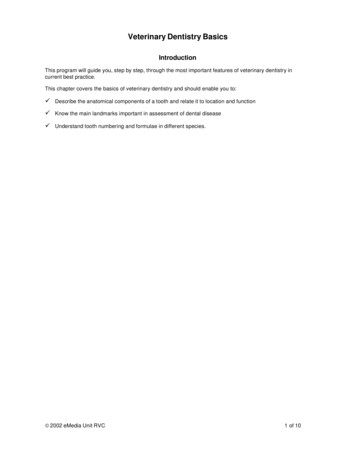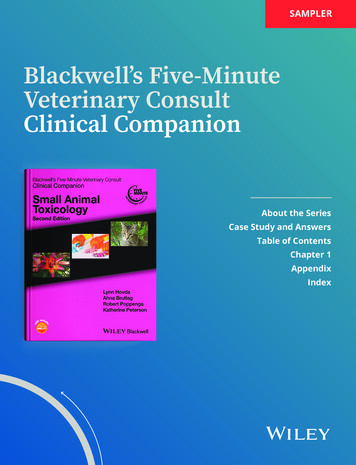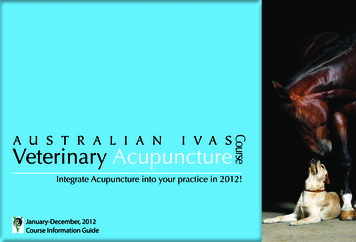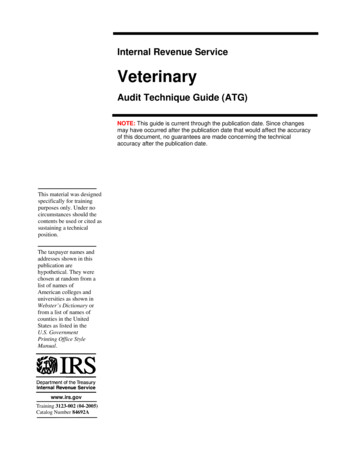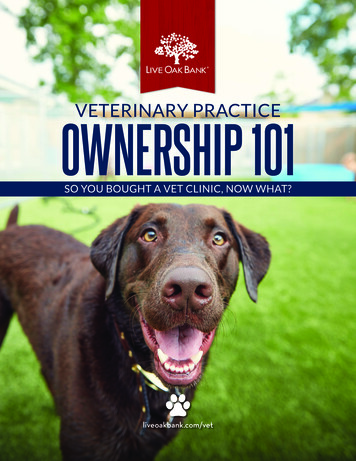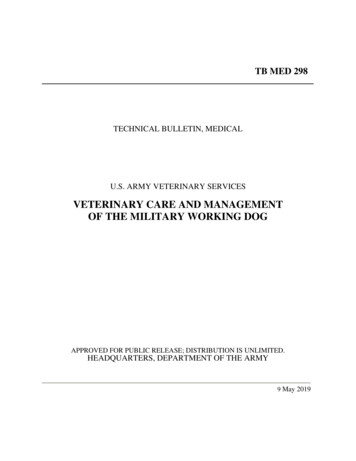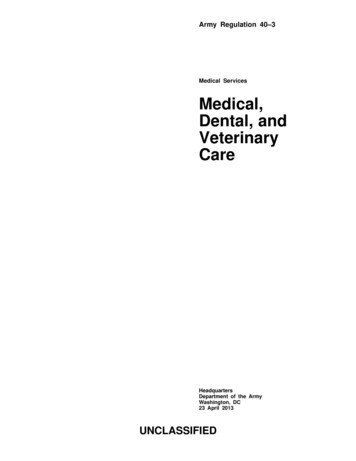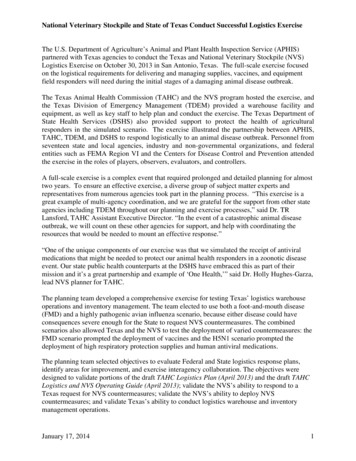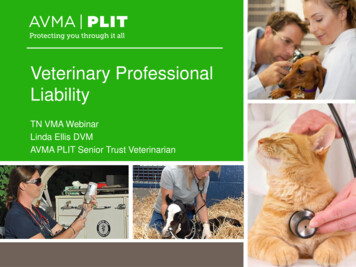
Transcription
PVM ReportPurdue University College of Veterinary Medicine2011 Annual Report EditionVol. XXXIV, Number 2
A Message from the Dean“What’s in a name?” It is a fair question, as immortalized in the lines ofWilliam Shakespeare’s “Romeo and Juliet.” The answer in the case of Purdue VeterinaryMedicine, is, “plenty!” And that is why, after careful thought and extensive discussion with faculty, staff, students, alumni and friends, we requested that our namebe changed from “School” to “College.” I am very pleased that the Board of Trusteesapproved that request in December, effective with the start of the 2012 spring semester.That’s why it is now possible for you to be reading the Purdue University College ofVeterinary Medicine Annual Report.It certainly can be said that this is truly a “change in name only.” Everythingelse is staying the same. But that doesn’t mean the change is insignificant. First impressions are very important, as are proper introductions. The term “School” hadbegun to hamper our effectiveness in helping people understand the breadth andstature of Purdue Veterinary Medicine. The name “College” more accurately reflectsthe size and scope of our programs. In addition to the doctorate of veterinary medicine program, we offer the baccalaureate degree and the associate degree in veterinary technology, as well as the Master of Science and Ph.D. degrees in a number ofbiomedical disciplines. Our faculty represents 20 different boarded specialties. Wehave residency programs that train future specialists for careers in private practiceand academia. We are home to scholars who are at the forefront of scientific discovery in their disciplines. This name change brings us more in line with the othermajor units on campus and reduces confusion by some who mistakenly believedthat we were part of another Purdue college. Additionally, the term “college” is usedby all but five of the 28 U.S. veterinary institutions. Being referred to as the PurdueUniversity College of Veterinary Medicine will help ensure an accurate understandingof our mission.Even though we have a new name, we will keep our same logo and short formname, Purdue Veterinary Medicine. And we will continue to emphasize those attributesthat are our hallmarks, including our steadfast commitment to excellence and diversity;our leadership in scientific discovery focused on our key areas of strength, includingcancer, infectious diseases, biomedical engineering and neuroscience; and our effectiveness in graduating practice ready veterinary professionals who are highly trainedin a setting that maximizes development of real-world, hands-on preparedness.There is one other attribute that will continue to define us, even as we adoptour new name of “College.” That attribute is the focus of this annual report: oursense of “family.” Nowhere is the idea of a veterinary “family” more real than atPurdue University. As you thumb through this issue, whether in print, or on a computer monitor or a smart phone, take time to read the stories that showcase thiswonderful family characteristic that will continue to be at the heart of what makesthe Purdue University College of Veterinary Medicine such a special place.Willie M. Reed, DVM, Ph.D.2— 2011 PVM Report —
It's LikeFamilyDeanWillie M. ReedAssociate DeansS. Kathleen SalisburyHarm HogenEschSandra AmassDirector of AdvancementCarol WilloughbyDirector of DevelopmentBecky HersheyEditorKevin DoerrDesignerElaine Scott DesignContributing WritersKevin DoerrBecky HersheyKay HagenKelli Anne WhiteCarol WilloughbyPhotographySeth BossinghamKevin DoerrEd LauschSam RoyerPurdue Marketing & MediaThis issue of the PVM Report waspublished through donations fromgenerous alumni and friends.Please visit us at the College’s Web site:www.vet.purdue.edu.On the cover:“Joe” Cooley provided unwavering and vital support tohis companions, Pat and Beth Cooley, after both of themwere diagnosed with cancer. Then, Joe found himself in asimilar fight against the disease. Read the touching story ofthis family’s togetherness in seeking out the best possiblecare while battling “Against the Odds,” on page 24.This Annual Report issue of the PVM Report focuses on family ties that linkalumni, students, donors, clients and faculty and staff of the Purdue UniversityCollege of Veterinary Medicine. It is often said that Purdue Veterinary Medicine“feels like family,” and the feature articles below will help explain why that’strue. Note that, as this publication was going to press, our name changed from“School” to “College” (see “Dean’s Column” on facing page). While most references to our name in this publication reflect that change, in some instances,the use of the word “School” was retained for appropriate historical context.4 Veterinary Medicine - Family StyleRead the stories of Purdue veterinary alumni who’ve madeprivate practice a family affair.10 News and NotesCatch-up on news about alumni, faculty and staff.18 Animal Response TeamRead how a shared desire to help animals in emergencies broughttogether a firefighter and a Purdue Veterinary Medicine alumna.20 PVAA Membership RosterA thank you to the alumni who support the Purdue VeterinaryAlumni Association through membership dues.24 Discovery Team“Against the Odds” is a story about a dog named “Joe” whohelped his “family” in its fight against cancer.26 Delivery TeamShelter Medicine is the focus of an exciting new mobile unitthat will help veterinary students serve and learn “on the road.”28 A Hero's ShadowK9 Shadow brings new meaning to the word “healing” for thePurdue Veterinary Medicine team called on to treat the injurieshe sustained in a tragic shooting.32 Engagement TeamSee photos that capture memories from the 2011 Purdue VeterinaryMedicine Continuing Education Conference and Homecoming.40 Teaching TeamAwards recognize outstanding faculty and staff.42 Veterinary Student Dads - and Moms Too!Read how veterinary students meet the challenges of raisingchildren in the midst of the demands of veterinary school.44 Donor TributesPlanning your tribute to the Human-Animal Bond isa “Matter of the Will.”46 Donor Honor Roll— 2011 PVM Report —3
Veterinary Medicine Family StyleThe phrase, “Purdue Veterinary Medicine family” has a very literal meaning for some graduatesof the Purdue University College of Veterinary Medicine. Over the years a number of secondgeneration veterinary students have followed in their parents’ footsteps, while others sharePurdue Veterinary Medicine ties as brothers and sisters, or spouses. The following stories give apersonal look at a few of these teams of Purdue veterinary alumni, revealing how they have carried the concept of the Purdue Veterinary Medicine “family” far beyond the walls of Lynn Hall.by Kevin DoerrThe Coolman StoryWhen Dr. Roy Coolman completed veterinary school as amember of the Class of 1965, he and his classmate and soon-tobe business partner, Dr. David Thoma, were focused on startingtheir own veterinary practice in Fort Wayne. The prospect thatsomeday Roy would welcome his own son into the practice as apartner and colleague was barely a thought. More than 45 yearslater, that “thought” is a fact that has become a part of the Coolmanand Purdue Veterinary Medicine “family” history.This fall, Dr. Coolman was honored as a recipient of theCollege’s highest honor for alumni, the Distinguished AlumnusAward. His family was on hand for the Awards Celebration heldduring the annual Purdue Veterinary Medicine Fall Conference.The gathering of family on that occasion reflected the Coolman’slongstanding family approach to veterinary practice—one inwhich quality relationships are paramount.Roy’s son Bradley remembers that he was considered themost likely one of his siblings to follow in his father’s footsteps.“I was most apt to go to the clinic with Dad, whether just taggingalong or spending a day off of school with him,” recalls Bradley.“Mom’s first recollection of my interest in a veterinary careerdates back to when I was in the 8th grade and the goat I was raising for my 4-H project died. She remembers me saying that ‘if Iwas a veterinarian, that would not have happened!’”Being sensitive to their children’s interests without pushing them in a particular direction was very important to Roy andhis wife Nancy. Roy remembers, “When Bradley decided to go toveterinary school, he expressed interest in coming back to ourpractice, but it was always his decision. No pressure.”Bradley says his ultimate goal definitely was to come backto Fort Wayne to practice with his Dad. But he knew that whenhe did that, he would stay in Fort Wayne, so taking advantage ofchances to see and experience other opportunities had to comefirst. After earning his DVM degree at Purdue in 1992, Bradleycompleted an internship at Auburn University, and then servedthree years in the Army, working with the military police dog program. Knowing that time was marching on, and realizing that theopportunity to work with his Dad would not last forever, Bradleyleft the military and enrolled in a surgery residency at the University of Illinois.4— 2011 PVM Report —Meantime, Roy and his long-time business partner, David,were working on arrangements that would enable Bradley tocome on board. “It was always his decision whether he wouldcome back to Fort Wayne to practice here. But with a multipleperson practice, everyone had to be on board to make that happen.So, when Bradley indicated he wanted to come back, we had tostart planning for it.” Bradley’s success in achieving board certification as a surgeon also was a critical part of the plan. Bradleyrealized that it would help him to be most effective at his Dad’spractice if he had his own credentials and expertise—and hadestablished himself as his own person. The wisdom of thatapproach became evident as Bradley did join the practice.(left-right) Dr. Bradley Coolman and his mother, Nancy Coolmanwith Distinguished Alumnus Award recipient Roy Coolmanand PVM Dean Willie Reed.
“What he did with the skills he brought as a boarded surgeon and with the organizational skills he learned in the military ,” reflects Roy, “ he came in and took the practice to adifferent level.” Roy and his business partner David also had theirown part to play in the successful transition. “We were able to letgo,” said Roy. “One of the challenges when building a business isto let the next generation take it. Because of Bradley’s talents andskills, that was relatively easy for us to do.”As they worked side by side in the practice, they also experienced unique rewards. “We had a great relationship during thoseyears,” says Roy. “I learned from him and he learned from me.”Bradley adds, “it was a wonderful experience. There were challengesas well as great times. One of the greatest things was learning fromeach other and helping each other. I had more academic background and knowledge, but he had 35 years of experience.”The practice expanded and today consists of both the St. JoeCenter Veterinary Hospital and the Northeast Indiana VeterinaryEmergency Specialty Hospital. Roy says, “It is an incredible experience when your son comes in and takes what you did and buildsit to another level.”The change also opened a new chapter for Roy. As thepractice reached the point when it was time to consider hiringanother surgery specialist, Roy did some soul searching andopted to retire, which opened the door for him to invest his lifein another passion of his—a veterinary mission project that involved starting a dairy cattle operation in Ethiopia to benefit theindigenous people of that region. “It’s been a very rewarding andsatisfying experience.”And now, Bradley and his wife, Shindok, have eight children, which raises the question of whether a third generationfamily member might one day join Bradley in the practice. Timewill tell, especially since Bradley and Shindok are following thesame philosophy as Roy and Nancy did. Bradley says his oldestdaughter, who is now in high school, is looking at a possible career in human or veterinary medicine. And while he hopes herinterests lead her into the veterinary profession, he is content tolet her decide.The Haviar StoryFor David and Kathleen Haviar,the concept of a “veterinary family”was very real from the moment theirchildren could walk. “Our first clinicwas attached to the house,” recalls David, a member of the Purdue DVMClass of 1975 who settled in RockyHill, Conn., near Hartford. “Whenyou opened the door to the kitchen,you would walk right into the clinicreception area.” Consequently, as soonas their children, Jason and Kristin,began walking, they could find theirway into the Animal Hospital ofRocky Hill. In the mid ‘80s, the Haviars built a new separate clinicwith a house next to it. Even with the clinic being in a separate facility, going to the clinic was just a matter of “walking next door,”David explains. “The children were in it all the time. They alwayssaw us working with animals.”As a result, Jason and Kristin never really had a definitetime when they “decided to become a veterinarian.” They havebeen involved with veterinary medicine nearly all their lives. Asthe time to enroll in college approached, Jason, the oldest, optedfor his dad’s alma mater. That decision also eased the decisionmaking process for Kristin, who is younger by four school years.“When Jason got into Purdue, I was confident enough to say ‘yoursister will be right behind you,’” comments David. And that’sexactly what happened. As Jason began his veterinary studies,Kristin came to the Purdue campus as an undergraduate student.Dr. Jason Haviar and his father,Dr. David Haviar, celebratewith Dr. Kristin Haviar on theoccasion of her graduation fromveterinary school in 2007.“We had relatives in Indiana, and I was able to visit mygrandparents while I was going to school at Purdue,” Jason says.“I’m glad I went to Purdue. I really appreciated the surgery experience.” As the family celebrated Jason’s graduation from veterinaryschool in May 2003, they also helped Kristin prepare to begin herPurdue veterinary studies that fall semester. Kristin remembers,“When I started veterinary school, it was like stepping intoanother family. Everyone who knew Jason was very welcoming.”While Kristin worked on her DVM degree, Jason wasgaining experience during an internship at the West HartfordSpecialty Clinic in Connecticut. There he learned about treatingemergencies. “I liked not knowing what was coming in the door.It was exciting, even though there was a lot of stress.” Jason’s interest in emergency medicine was piqued.(continued next page)— Veterinary Medicine Family Style —5
Haviar Story (continued)After gaining additional practice experience, including a stint at a practice in North Carolina, Jasonfound himself faced with a new opportunity that wouldbring him back to his “veterinary family.” His Dad wasinterested in opening an emergency clinic that wouldoperate at the Animal Hospital of Rocky Hill during theevening hours. Jason was the perfect fit to help get theidea off the ground. “Lots of pieces of the puzzle fit together perfectly to allow us to get the emergency clinicopen,” recalls Jason. “Dad’s great work and reputationhelped us successfully launch the new service,” Jasonsaid. Called the Animal Emergency Hospital of CentralConnecticut, the facility took referrals during eveninghours in the same building that housed the day-timeveterinary practice. To help with the staffing needs, theHaviars hired a fellow Purdue graduate, who was justone class behind Jason, Chris Gargamelli (PU DVM ’04).Jason and Chris worked well together and developed aschedule that enabled Jason just the right combinationsof days off to pursue his hobby of deep sea fishing.“Being 80 miles from land, catching tuna and swordfish,you forget about everything else. It is good stress relief,”explains Jason.Four years after Jason’s graduation, Kristinearned her Purdue DVM degree, graduating in the Classof 2007. She was excited to return home. “I love being onthe east coast and I enjoyed getting started at my Dad’spractice and getting settled,” says Kristin. “Dad is a greatmentor and he helped me out a lot. I also helped sharewith him new information I had learned at Purdue. Itmade for a good partnership,” Kristin explains. “We area very close family. We spent lots of time together, andwe have stayed close throughout the years,” she said. Jasonadds, “When I come in for my shift at 5:30 in the evening,we can review cases together.” And David says he reallyappreciates his daughter’s knowledge of computers.Kristin concludes, “It’s easy to come to work everyday. We share ideas. It’s a great working environment.”And the family’s Purdue pride even shows through themessage that plays if the courteous and professionalclinic staff have to put a client on hold. The announcement emphasizes that all three veterinarians in the family that has owned the practice for more than 30 yearsare, indeed, Purdue grads!6— 2011 PVM Report —PVM Alumna ReachesNational Audiencethrough Satellite RadioTune in to XM SatelliteRadio channel 166 on a Saturdaybetween noon and 2:00 p.m., EST(9:00 a.m. - 11:00 a.m. PST), andchances are you will hear PurdueVeterinary Medicine alumnaDeborah White (PU DVM ’94)taking questions from callers, in her role as “call-in veterinarian.” Dr. White is on-air talent for a program called “AnimalRadio ,” which features a “Dream Team” of resource peoplefor pet owners, including a dog trainer, a pet travel expert,a groomer and an animal communicator. Dr. White’s role isto answer listeners’ questions about everything from serioushealth issues to wild and wacky pet behavior, and to help themmanage their pets’ health.Dr. White has been involved with “Animal Radio ”since 2007. The invitation to join the “dream team” was a natural outgrowth of other on-air work she had been doing inthe Las Vegas area. Her media work began unexpectedly whenshe was asked by a news anchor from a local station to be ajudge in a pet costume contest. That volunteer work led to anopportunity to become a regular contributor for a weekly petsegment in 2005. “I loved the experience and felt comfortablewith it,” comments Dr. White. A year later, she got involvedwith the Veterinary News Network, and served as a correspondent for the Western Veterinary Conference television system.For Dr. White, being involved with the media is a calling. “I like being in a position to provide accurate informationthat can help people formulate good opinions, and squash themisinformation that might otherwise get out.” That’s why shebecame a founding member of what is now called the AmericanSociety of Veterinary Journalists, and serves on the organization’s Board of Certification. “We screen veterinarians interested in working with the media and put a seal of approval onthose who have demonstrated the skill sets necessary to serveas spokespersons to the media.” As someone who herself hasboth the expertise and talent to do on-air work, Dr. White isinterested in becoming more involved in mass communication. “Book writing is another interest I would like to developif and when I’m able to free up time from clinic duties,” saysDr. White.To find out more about Dr. White’s role on “AnimalRadio ,” see http://animalradio.com/ARNPROG.html. Find alist of affiliate stations that carry “Animal Radio ” at http://animalradio.com/stations.html
Veterinary Practice Family StyleMarried, with Practices For Drs. Deborah White (PU DVM ’94)and Kurt Mychajlonka (PU DVM ‘93), “veterinary family” means starting and ending eachwork day together, but spending the workday itself at separate but co-owned veterinarypractices. Kurt and Deborah were just one yearapart when they enrolled as veterinary studentsat Purdue. A friendship blossomed. “We wereboth in OTS, and got introduced through that,”recalls Kurt. When Kurt graduated, he opted toseek out openings in Las Vegas, where he heardthat there would be lots of opportunities to pursue his
puter monitor or a smart phone, take time to read the stories that showcase this wonderful family characteristic that will continue to be at the heart of what makes the Purdue University College of Veterinary Medicine such a special place. Willie M. Reed, DVM, Ph.D. Geckler Veterinary Hospital, LLC Indianapolis, IN

